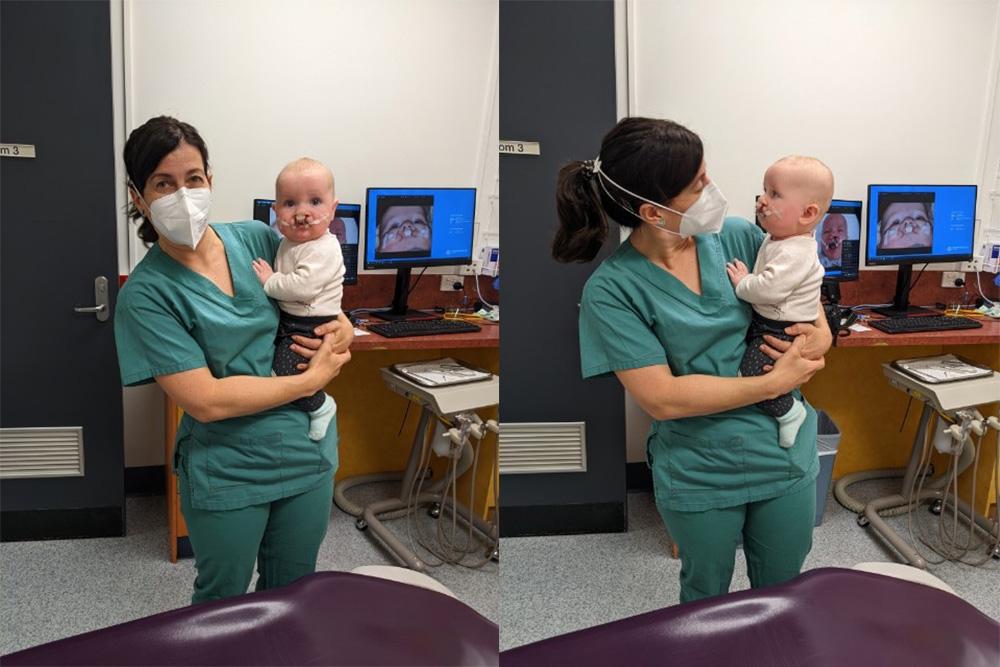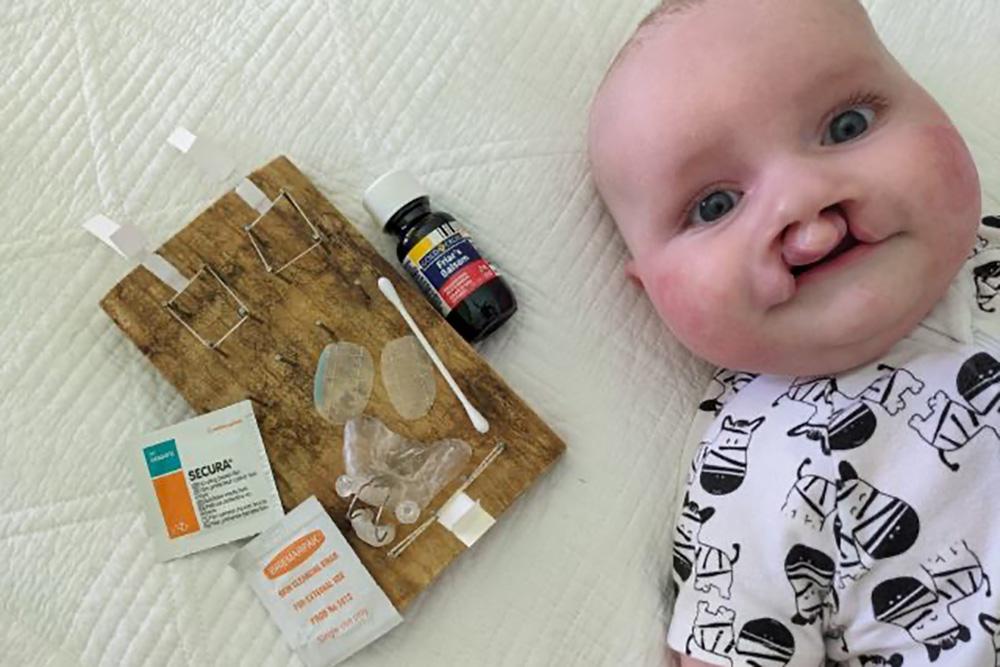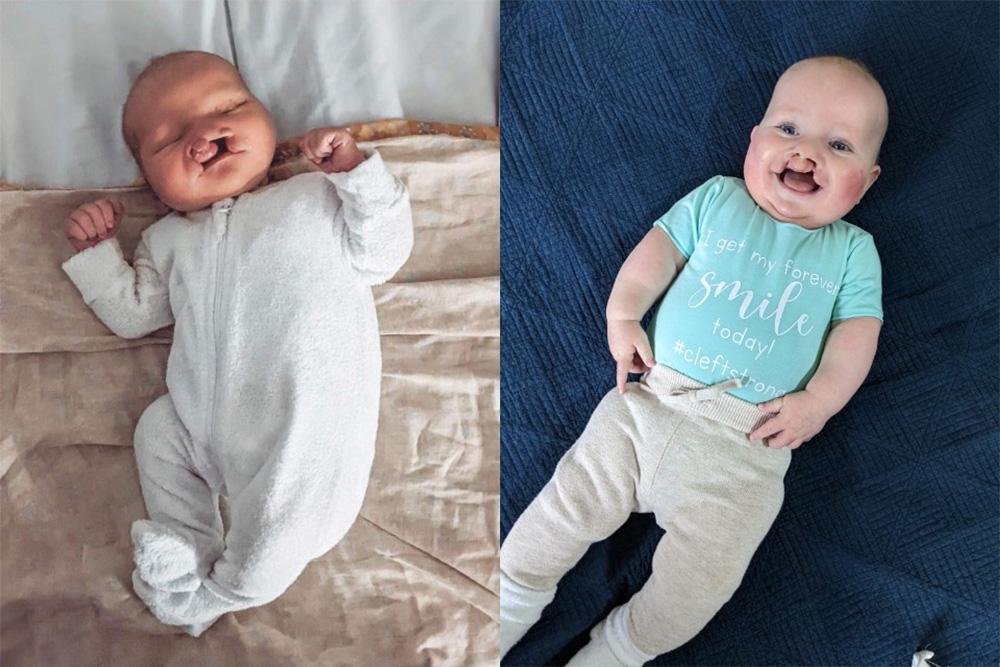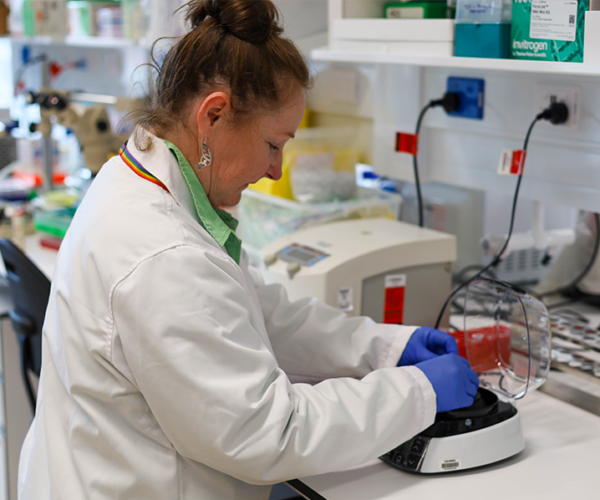Babies born with cleft lip and/or palate in South Australia now have access to the gold standard of care in the lead-up to surgery thanks to a new moulding service at the Women’s and Children’s Hospital (WCH).
The Naso-Alveolar Moulding (NAM) service improves the surgical outcomes of babies born with cleft lip and/or palate by offering patients pre-surgical intervention prior to lip repair at four months of age.

Dr Kelly Oliver and Percy with his NAM mould in place.
How the NAM service works
Dr Kelly Oliver is the Medical Unit Head of the WCH Paediatric Dental Department.
She says, “Many centres worldwide consider NAM the gold standard of pre-surgical orthopaedic care prior to lip and nose repair.”
The NAM therapy works by gently directing the growth of the baby’s gums and shaping of the nose by reducing the cleft inside the mouth with a plate. During the first few months after birth, these tissues are soft and easy to mould. This process reduces the gap in the upper lip and lifts and narrows the nose.
The baby wears the plate 24/7 and sees the NAM team at the Hospital every one to two weeks for minor adjustments as required.
Approximately 15-20 babies are born in South Australia every year with cleft lip and palate who would potentially benefit from NAM. These children require multiple operations from infancy through to adulthood.
Dr Oliver says, “There are several benefits of the NAM technique in the treatment and outcomes for babies with cleft lip and palate.”
“Correct alignment helps the surgeon to achieve a better and more predictable surgical result. The size of the cleft is reduced with the use of NAM therapy before surgery, making the primary repair of the lip and nose a simpler surgery.”
“Long-term studies of NAM therapy indicate that the change in the nasal shape is stable with less scar tissue and better lip and nasal form. Additionally, parents report feeling satisfaction that they are contributing towards their child’s care.”

Percy’s NAM station, crafted by his dad.
Percy’s story
Percy was the very first patient to undergo NAM therapy at the Women’s and Children’s Hospital.
His mum, Stephanie, had confirmation at her 20-week ultrasound scan that he had a bilateral cleft lip and palate, which meant he would be born with openings on both sides of his upper lip and the roof of his mouth.
Stephanie says, “I was blown away. It was a big shock. I didn’t know anyone with a cleft lip or palate and I didn’t know anything about it.”
A few months later, Percy was born at the WCH. Stephanie says, “My eldest, who is four years old, said, ‘He looks like a teddy bear,’ because of how teddy bears’ lips are kind of like that. I thought it’s a nice way of describing it!”
The day Percy and Stephanie were discharged from the Hospital, they met Dr Oliver.
Stephanie says, “She came and spoke to us and mentioned we had couple of options: we could try taping or do the NAM therapy, so we said we’d be open to trying it. A couple of weeks later we saw her again and she took moulds of his mouth and it just went from there.”
Percy wore the plate all day, and Stephanie could change it at home, which was made even easier thanks to an innovative set-up station her husband made.
She says, “Doing the NAM has been a bit of work, but it’s honestly not been hard.”
“I feel like it’s been no effort on our behalf.”
In just months, the gap in Percy’s lip went from 14mm down to just 2mm.
Stephanie says, “It’s a huge difference!”
“It’s amazing getting those kinds of results before surgery.”
“The NAM was the best thing. It didn’t hurt him, and it was so easy to guide the direction of growth.”
At six months old, Percy underwent his first surgery to repair his lip.
Stephanie says it all went really well and Percy has recovered amazingly.

Percy before and after using the NAM mould, ready for surgery.
SA Power Networks Employee Foundation
The NAM Service is a joint initiative of the Cleft & Craniofacial SA and Paediatric Dentistry Units, funded by the WCH Foundation thanks to the generous support of SA Power Networks Employee Foundation.
Stephanie says, “I think we’re really blessed. I’m really, really grateful that the WCH Foundation invested the money into doing this, and I’m so grateful that Percy could be part of it.”
Dr Oliver says, “These funds will be used to supply initial consumables, equipment and education materials required to provide our babies in need of this service with access to NAM.”
“Additionally, this will provide an opportunity to upskill staff and a local technician in this niche field and serve as a pilot to build the most ideal service for our population’s needs.”




